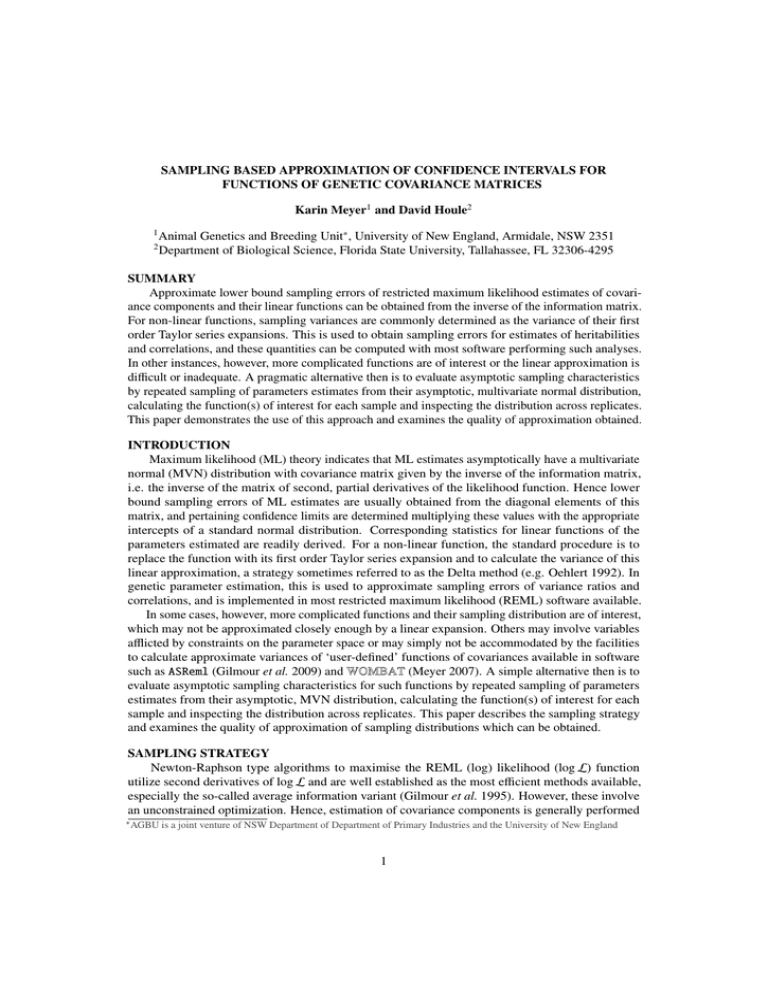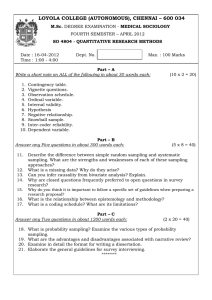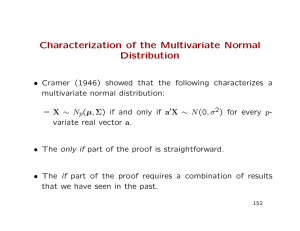Sampling based approximation of confidence intervals for functions
advertisement

SAMPLING BASED APPROXIMATION OF CONFIDENCE INTERVALS FOR
FUNCTIONS OF GENETIC COVARIANCE MATRICES
Karin Meyer1 and David Houle2
1
2
Animal Genetics and Breeding Unit* , University of New England, Armidale, NSW 2351
Department of Biological Science, Florida State University, Tallahassee, FL 32306-4295
SUMMARY
Approximate lower bound sampling errors of restricted maximum likelihood estimates of covariance components and their linear functions can be obtained from the inverse of the information matrix.
For non-linear functions, sampling variances are commonly determined as the variance of their first
order Taylor series expansions. This is used to obtain sampling errors for estimates of heritabilities
and correlations, and these quantities can be computed with most software performing such analyses.
In other instances, however, more complicated functions are of interest or the linear approximation is
difficult or inadequate. A pragmatic alternative then is to evaluate asymptotic sampling characteristics
by repeated sampling of parameters estimates from their asymptotic, multivariate normal distribution,
calculating the function(s) of interest for each sample and inspecting the distribution across replicates.
This paper demonstrates the use of this approach and examines the quality of approximation obtained.
INTRODUCTION
Maximum likelihood (ML) theory indicates that ML estimates asymptotically have a multivariate
normal (MVN) distribution with covariance matrix given by the inverse of the information matrix,
i.e. the inverse of the matrix of second, partial derivatives of the likelihood function. Hence lower
bound sampling errors of ML estimates are usually obtained from the diagonal elements of this
matrix, and pertaining confidence limits are determined multiplying these values with the appropriate
intercepts of a standard normal distribution. Corresponding statistics for linear functions of the
parameters estimated are readily derived. For a non-linear function, the standard procedure is to
replace the function with its first order Taylor series expansion and to calculate the variance of this
linear approximation, a strategy sometimes referred to as the Delta method (e.g. Oehlert 1992). In
genetic parameter estimation, this is used to approximate sampling errors of variance ratios and
correlations, and is implemented in most restricted maximum likelihood (REML) software available.
In some cases, however, more complicated functions and their sampling distribution are of interest,
which may not be approximated closely enough by a linear expansion. Others may involve variables
afflicted by constraints on the parameter space or may simply not be accommodated by the facilities
to calculate approximate variances of ‘user-defined’ functions of covariances available in software
such as ASReml (Gilmour et al. 2009) and WOMBAT (Meyer 2007). A simple alternative then is to
evaluate asymptotic sampling characteristics for such functions by repeated sampling of parameters
estimates from their asymptotic, MVN distribution, calculating the function(s) of interest for each
sample and inspecting the distribution across replicates. This paper describes the sampling strategy
and examines the quality of approximation of sampling distributions which can be obtained.
SAMPLING STRATEGY
Newton-Raphson type algorithms to maximise the REML (log) likelihood (log L) function
utilize second derivatives of log L and are well established as the most efficient methods available,
especially the so-called average information variant (Gilmour et al. 1995). However, these involve
an unconstrained optimization. Hence, estimation of covariance components is generally performed
* AGBU
is a joint venture of NSW Department of Department of Primary Industries and the University of New England
1
employing a re-parameterisation to functions which do not require constraints to ensure positive
(semi-) definite estimates of covariance matrices. A common choice for covariance matrices is to
estimate the elements of their Cholesky factors, transforming diagonal elements to logarithmic scale
(Meyer and Smith 1996). Furthermore, factorising with pivoting on the largest diagonal readily
facilitates reduced rank analyses (Meyer and Kirkpatrick 2005).
In addition, such parameterisation directly allows sampling of estimates of covariance matrices
– constructed by reversing the transformation – which are guaranteed to be in the parameter space,
directly mimicking the constraints imposed in REML estimation. Let θ̂, of length p, denote the
vector of parameter estimates and H = Var(θ̂) the corresponding inverse of the information matrix at
convergence. Samples of parameters from N(θ̂, H) are then obtained as θ̃ = θ̂ + LH d with LH the
Cholesky factor of H and d a vector of standard normal deviates, di ∼ N(0, 1). Samples of covariance
matrices Σ̃ can then be constructed from θ̃.
APPLICATION
Data for 6 traits recorded on 4000 individuals in 500 independent families of size 8 were simulated
for the design of Bondari et al. (1978). Population parameters assumed all residual correlations were
equal to 0.3. Heritabilities were 0.2, 0.3 and 0.4 for two traits each, and all phenotypic variances were
equal to 100. For Case I, all genetic correlations were assumed to be equal to 0.5, while for case II
values for traits i and j were 0.7|i− j| .
REML estimates of genetic and residual covariances matrices were obtained fitting an animal
model, using an average information algorithm. Three estimates of sampling (co)variances for
covariance components were contrasted:
A) Values from the REML analysis, obtained from H using the Delta method. Let σi j denote the
elements of a covariance matrix Σ = LL0 , with L = {li j } its Cholesky factor. For Cov(lˆi j , lˆkm )
given by the corresponding element of H, Cov(σ̂i j , σ̂kl ) is approximated as
fX
(i, j) fX
(k,m)
lˆjt lˆms Cov lˆit , lˆks + lˆjt lˆks Cov lˆit , lˆms + lˆit lˆms Cov lˆjt , lˆks + lˆit lˆks Cov lˆjt , lˆms
t=1
s=1
with f (i, j) = min(i, j, r), and r the rank at which Σ is estimated. Similar formulations apply when
diagonal elements lii are transformed to logarithmic scale or for covariances among components
belonging to matrices Σ pertaining to different sources of variation.
B) Empirical values obtained by repeatedly sampling data for the given structure from appropriate
normal distributions with population values equal to the estimates of covariances, and carrying
out a REML analysis for each sample. A total of 10,000 analyses were performed, and sampling
variances determined as the variances across replicates.
C) Approximate values obtained as covariances across 200,000 samples drawn from a MVN distribution as described above.
For both empirical and MVN samples, 95% confidence intervals were obtained after sorting samples
in numerical order as the mid-points between the 2.5% top and bottom samples and the remainder.
REML estimation and sampling from the MVN distribution were carried out using WOMBAT.
Results. Estimates of sampling covariances among the distinct elements of the genetic covariance
matrix (Σ̂G ) for case I are contrasted in Figure 1, showing excellent agreement between all three values
[ depicting variances Var(σ̂G i j ) and • covariances Cov(σ̂G i j , σ̂G kl )]. For case II, the estimate of the
smallest genetic eigenvalue was not significantly different from zero, i.e. a full rank estimate of ΣG
represented an over-parameterised model. As illustrated in Figure 2, this resulted in an overestimate of
Var(σ̂G i j ) obtained from the MVN approximation. The component affected pertained to the variance
of the trait considered last in the Cholesky decomposition of ΣG , i.e. the overestimate reflected
2
10
5
●
●
●●
●
●
●
●
●
●
●
●
●
●
●
●
●
●
●
●
●
●
●
●
●
●●
●
●
●
●
●
●
●
●
●
●
●
●
●
●
●
●
●
●
●
●
●
●
●
●
●
●
●
●
●
●
●
●
●
●
●
●
●
●
●
●
●
●
●
●
●
●
●
●
●●
●●
●
●
●
●
●
●
●
10
5
5
10
15
Approximate
15
Approximate
Empirical
15
15
●
●●
●
●
●
●
●
●
●
●
●
●
●
●
●
●
●
●
●
●
●
●
●
●
●
●
●
●
●
●
●
●
●
●
●
●
●
●
●
●
●
●
●
●
●
●
●●
●
●●
●
●
●
●
●
5
5
10
REML
10
●●
●
●●
●
●●
●
●
●●
●
●
●
●
●
●
●
●
●
●
●
●
●
●
●
●
●
●●
●
●
●
●
●
●
●
●
●
●
●
●
●
●
●
●
●
●
●
●
●
●
●
●
●
●
●
●
●
●
●
●●
●
●
●
●
●
●
●
●
●
●
●
●
●
●
●
●
●
●
●
●
●
●
●
●
●
●
15
5
REML
10
15
Empirical
Figure 1. REML, empirical and approximate sampling (co)variances for case I
accumulation of errors for a redundant parameter. Reducing the number of parameters by estimating
ΣG at reduced rank again yielded very good agreement between empirical and approximated values.
Empirical and approximated sampling distributions for selected functions of covariances are
compared in Figure 3, with left and right solid vertical bars marking the 95% confidence limits
obtained as truncation points between the top and bottom 2.5% of samples and dashed bars showing
their ‘standard’ counterparts, 1.96 standard deviations either side of the mean. Again, there was
close agreement between empirical results obtained by re-sampling data and the MVN approximation.
For functions at the boundary of the parameter space, such as the genetic correlation between traits
1 and 2, sampling distributions tend to be skewed and confidence intervals derived directly from
the distribution tend to be more appropriate than those calculated from sampling errors and normal
intercepts. Estimates of genetic eigenvalues are generally reported without any measure of their
P
precision. Similarly, canonical eigenvalues and the number of effective dimensions, i λi /λ1 (with λi
the eigenvalues of the matrix of (co)heritabilities and λ1 the largest value; Kirkpatrick (2009)) are
functions of both genetic and phenotypic covariance matrices, and calculation of sampling variances
using the Delta method would be tedious while it is straightforward using MVN sampling.
DISCUSSION
By definition, REML estimation of covariance components involves the solution of a constrained
optimisation problem. Fortunately, this task can be made easier by a transformation to parameters
which do not require constraints to yield valid estimates of covariance matrices. Sampling from
the asymptotic distribution of these parameters has been shown to yield numerical estimates of
sampling covariances, distributions and confidence intervals in close agreement with those obtained
by resampling data. It has to be emphasized though that for this to hold, large sample properties
need to apply, i.e. the inverse of the information matrix has to provide an adequate description of
Rank 6
Approximate
15
10
10
●
●
●
5
Rank 5
15
●
●
●
●●
●
●
●
●●
●
●
●
●
●
●
●
●●
●
●
●●
●
●
●
●
●
●
●
●
●
●
●
●
●
●
●
●
●
●
●
●
●
●
●
●
●
●
●
●
●
●
●
●
●
●
●
●
●
●
●
●
●●
●
●
●
●
●
●
●
●
●
●
●
●
●
●
●
●
●
●
●
●
●●
●
●
●
●
●
●
●
●
●
●
●
●
●
●
●
●
5
5
10
Empirical
15
●
●
●
●
●
●●
●●
●
●●
●●
●
●
●
●
●
●
●
●
●
●
●
●
●
●
●
●
●
●
●
●
●
●
●
●
●
●
●
●
●
●
●
●
●
●
●
●
●
●
●
●
●
●
●
●
●
●
●
●
●
●
●
●
●
●
●
●
●
●
●
●
●
●
●
●
●
●
●
●
●
●
●
●
●
●
●
●
●
●
●
●
●
5
10
15
Empirical
Figure 2. Empirical vs. approximate sampling (co)variances for case II
3
Largest genetic eigenvalue
Largest canonical eigenvalue
Effective no. dimensions
Approximation
Empirical
Genetic correlation 12
0.6
0.7
0.8
0.9
1.0
80
100
120
140
160
180
0.40
0.50
0.60
1.4
1.5
1.6
1.7
1.8
1.9
Figure 3. Sampling distributions and confidence intervals for selected functions (Case II)
sampling covariances among the parameters estimated. If this is not the case, estimates of confidence
limits derived from the profile likelihood for individual parameters may be more appropriate (Meyer
2008). In addition, the sampling procedure was found to be sensitive to an overparameterised model,
yielding overestimates of sampling variances for redundant parameters, and care needs to be taken for
multivariate analyses of more than a few traits to estimate covariance matrices at the appropriate rank.
To facilitate use of the approach described, an option to invoke sampling of parameters from their
asymptotic distribution together with the transformation to estimates of covariance matrices has been
implemented in our REML package WOMBAT as a post-estimation step. This yields a file with
samples of covariance matrices suitable for input to a package such as R (R Core Team 2012) to
evaluate the functions of interest and compute summary statistics.
CONCLUSIONS
Sampling of REML estimates from their asymptotic MVN distribution, specified by the inverse
of the information matrix, offers a straightforward and computationally undemanding way to derive
sampling distributions and confidence intervals for estimates of covariance components and ‘nonstandard’ functions thereof numerically. It is a small but useful addition to our toolkit for estimation.
REFERENCES
Bondari K., Willham R.L. and Freeman A.E. (1978) J. Anim. Sci. 47:358.
Gilmour A.R., Thompson R. and Cullis B.R. (1995) Biometrics 51:1440.
Gilmour A.R., Gogel B.J., Cullis B.R. and Thompson R. (2009) ASReml User Guide Release 3.0.
VSN International Ltd, Hemel Hempstead, HP1 1ES, UK.
Kirkpatrick M. (2009) Genetica 136:271.
Meyer K. (2007) J. Zhejiang Uni. SCIENCE B 8:815.
Meyer K. (2008) Heredity 101:212.
Meyer K. and Kirkpatrick M. (2005) Genet. Sel. Evol. 37:1.
Meyer K. and Smith S.P. (1996) Genet. Sel. Evol. 28:23.
Oehlert G.W. (1992) Amer. Stat. 46:27.
R Core Team (2012) R: A Language and Environment for Statistical Computing. R Foundation for
Statistical Computing, Vienna, Austria.
This work was funded by Meat and Livestock Australia under grant B.BFG.0050. short blurb about NIMBIOS
4





